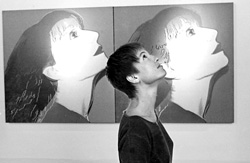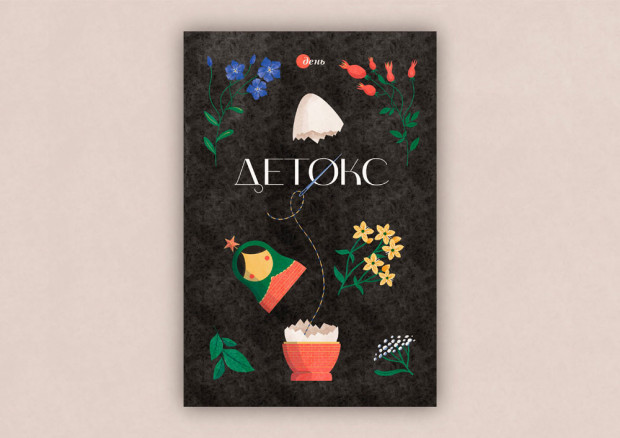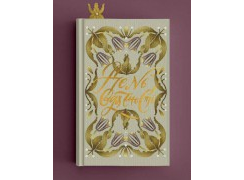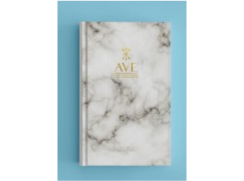ANDY WARHOL’S TIN CAN TRUTH

Almost 25 years after the death of Andy Warhol (born Andrew Warhola), a celebrated as much as extravagant US artist, an exposition of his works was organized at Kyiv’s Modern Art Center, a place traditional for this kind of exhibit.
It would be hard to add anything to what is said about Warhol above, the more so that the artist constantly provoked such an avalanche of information. And yet he remains one of the most enigmatic figures of the past century. Behind numerous external manifestations this lean fair-haired and conceited gentleman managed to hide so well that it is unclear what one actually means: a human being or a face from a 1986 portrait more like a spot left by a brain shot out of someone’s head in a horror movie.
A visit to the Kyiv exhibit makes one relaxed and comfortable, the way one feels on first stepping into a rich and well-designed office. One encounters giant dollar signs, tinted photo prints of the electric chair, fluorescent crosses against a black background, Campbell’s soup cans, a standard Coca-Cola bottle, khaki-colored Statue of Liberty facing a giant Hammer-and-Sickle done in tender white shades, Tuna Disaster (several identical photos of canned fish), Mao Zedong’s yellow- brown portrait copied from official illustrations. Everything is painted — rather, printed — very simply, with no frills. Circulation, mass output were the cornerstones of the pop artist. Moreover, apart from early pencil sketches, Warhol never drew or painted anything himself. His numerous canvases (he was remarkably productive) were made by means of photographic silk screen prints, using newspaper photos, posters, or something. In a word, no author’s work except pressing a button and starting a machine.
Some of Warhol’s works, albeit not displayed in Kyiv simply because they could not be displayed, went down into history also rather confidently. Velvet Underground in the first place, of course, and the cool suggestive singer Nico. Also, the new film-making principle. Warhol made a host of films, totally oblivious to public preferences, using his favorite cheap conveyer method, spending miles of film shooting skyscrapers, people eating or sleeping. Finally, his Factory made in the 1960s, destined to become a must when decorating the premises for youth gatherings anywhere in the world. Warhol bought a discarded factory building in downtown New York and remained true to his serial output principle. His Factory produced an entirely new type of artistic existence where work and leisure were practically indistinguishable and equally unimportant. Carousing, onsite shooting, film-viewing, music, homosexuality, heavy group drinking, motley company with celebrities sharing joints with hippies — a bizarre mix boiling like amalgam in an alchemist’s cauldron. However, instead of elixir Warhol received a bullet from a mentally unbalanced actress, but managed to turn even his wound into an asset. Now he ranked with the great victims of the 1960s, including John and Robert Kennedy, Martin Luther King, and Sharon Tate, except that he survived.
Among Warhol’s works there were also scandals, carousing, an attempt on his life, and rock groups. As a man of the arts (and this should be stressed again), he was illusory, unreal. In his case one comes across an amazing convergence of extremes which in itself matches Mona Lisa’s smile. Just as an artist working in the elite, highbrow sphere turns into a name, a priest perched on top of a sky- high tower, totally aloof from all things mundane, Warhol managed to shed his works of all signs of individuality, leaving only his name, using it to mark all kinds of garbage. Hypnotized, the artistic community, in turn, recognized all that garbage as marking Andy Warhol as art.
An obvious replacement. Art, it appears, can be anything. A technique which is anything but new. Back in 1920, Marcel Duchamp displayed a urinal at an art gallery and romantically titled it Fountain. This was the first of what came to be known as ready-mades, ordinary objects made into art simply by changing their context — that is, by exhibiting them as art. Bicycle Wheel was soon followed by other ready-mades, most notoriously a urinal whimsically called Fountain and submitted collaboratively with American artist Joseph Stella to a 1913 So you wanted high art? Please read the advertisement! The biggest paradox is that Andy Warhol is not an artist. It is the absence of an artist, an anonymous heap of clichОs and stencils without any individual messages whatsoever. Here at this seemingly dead-end begins the labyrinth of cruel jokes which Warhol built during his lifetime. The thing is that he portrayed the surface of the world and of things very accurately and very timely. The twentieth century, especially after World War II, was nothing but consumption and consumption and consumption. And consumption is not so much important as is its process: advertising, investing, looking good, dressing and living well. In fact, man nowadays is made up of goods and their consumption. Therefore, by painting Green Coca Cola Bottles (1962) Warhol painted contemporary man. Just as a harmoniously developed torso or face twisted with excruciating pain had once served as ideal artistic models, so is now a bright red slightly dented empty Campbell’s soup can. Cruel, yes, but that’s an objective fact expressed with a ruthless straightforwardness. Man today is not the king of the universe, nor is he an ancient handsome athlete or nervous romantic. Just a dented empty can. This is how people live and precisely how they treat each other, emptying, crumpling, and dumping.
Such is the sad message of pop art, a message from Andy Warhol. He suggests that one take a look at oneself, a suggestion no one can reject. The meaning of the easy life is that life can never be easy. By making art easy, Warhol made life easy, too, so much so it is frightening.
However, people exploring the exposition called Warhol, Superstar Artist seem unafraid.






